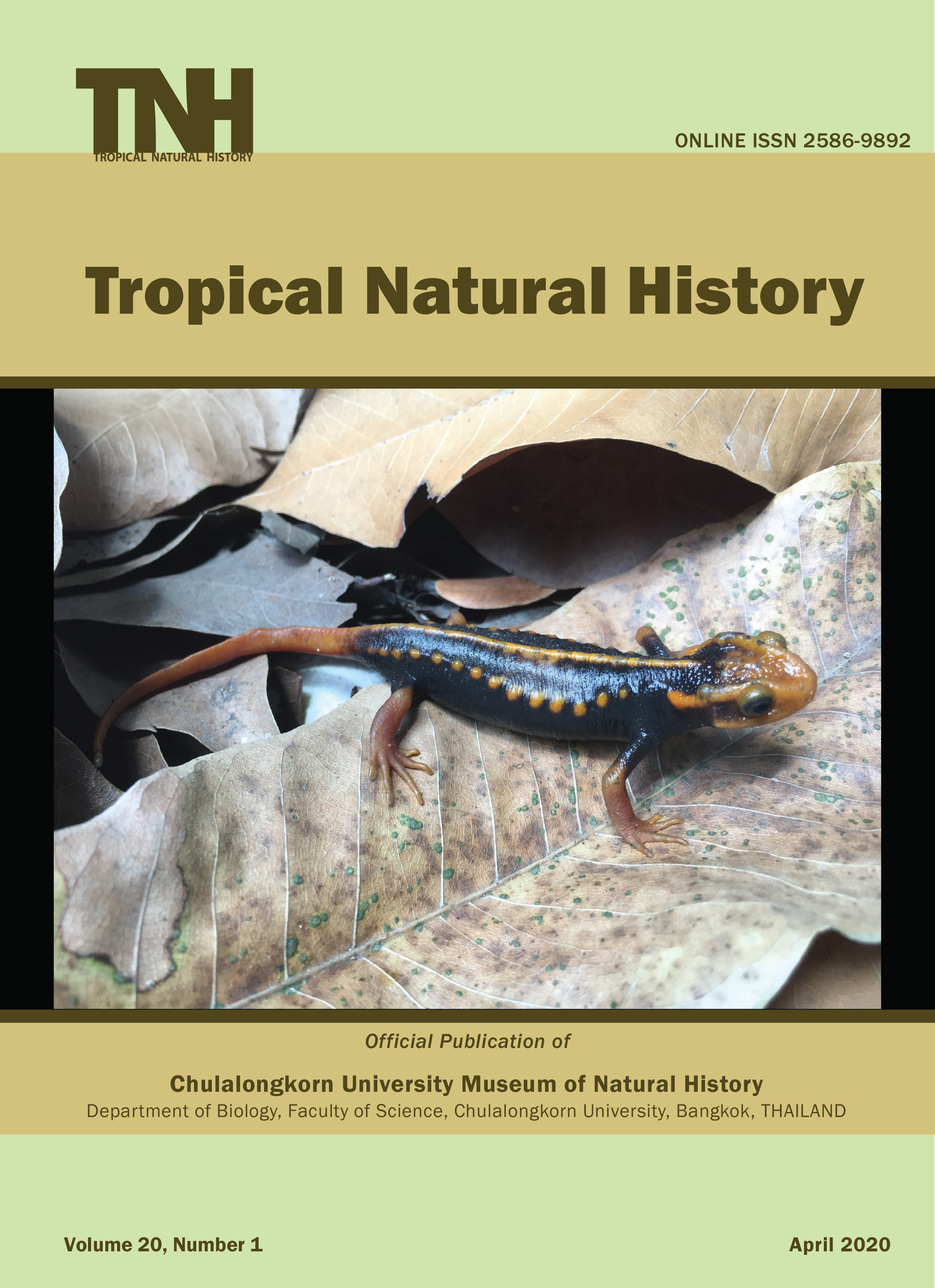Has Halophila beccarii Ascherson (Alismatales, Hydrocharitaceae) Been Locally Extirpated in the Philippines?
DOI:
https://doi.org/10.58837/tnh.20.1.206130Abstract
There is no Abstract for this type of manuscript (Short Notes).
References
Larkum, A.W.D. 1995. Halophila capricorni (Hydrocharitaceae): a new species of seagrass from the Coral Sea. Aquatic Botany 51: 319-328. https://doi.org/10.1016/0304-3770(95)00474-E.
Green, E.P. and F.T. Short, eds. 2003. World Atlas of Seagrasses. Prepared by the UNEP World Conservation Monitoring Centre. University of California Press, Berkeley. 310 pp.
Yang, Y.P. 2000. Hydrocharitaceae. In: Flora of Taiwan, 2nd ed, vol. 5. Department of Botany, National Taiwan University, Taipei, 11-19.
Merrill, E.D. 1912. A Flora of Manila. Philippine Islands Bureau of Science, Publication 5, Manila. 508 pp.
Mendoza, D. and R. del Rosario, R. 1967. Philippine Aquatic Flowering Plants and Ferns. Philippine National Museum, Publication 1, Manila. 53 pp.
Den Hartog, C. 1970. Sea-grasses of the World. North-Holland Publishing Co., Amsterdam. 275 pp.
Meñez, E.G., R.C. Phillips and H.P. Calumpong. 1983. Seagrasses from the Philippines. Smithsonian Contributions to the Marine Sciences, 21: 1-40. https://hdl.handle.net/10088/22486.
Phillips, R.C. and E.G. Meñez. 1988. Seagrasses. Smithsonian Contributions to the Marine Sciences, 34: 1-104. https://hdl.handle.net/10088/22491.
Uchimura, M., E.J. Faye, S. Shimada, G. Ogura, T. Inoue and Y. Nakamura. 2008. A reassess-ment of Halophila species (Hydrocharitaceae) diversity with special reference to Japanese representatives. Botanica Marina 51: 258-268. https://doi.org/10.1515/BOT.2008.036.
Meñez, E.G. and H.P. Calumpong. 1997. Field Guide to the Common Mangroves, Seagrasses and Algae of the Philippines. Bookmark, Inc., Makati City.
Fortes, M., E. Green and F. Short. 2003. The Seagrasses of the Philippines and Viet Nam. In: E.P. Green and F.T. Short (eds.) World Atlas of Seagrasses. Prepared by the UNEP World Conservation Monitoring Centre. University of California Press, Berkeley, 183-184.
Reichardt, W., M.L. San Diego-McGlone and G.S. Jacinto. 2007. Organic pollution and its impact on the microbiology of coastal marine environments: A Philippine perspective. Asian Journal of Water Environment Pollution, 4: 1-9. https://content.iospress.com/articles/asian-journal-of-water-environment-and-pollution/ajw4-1-01.
Short, F.T., B. Polidoro, S.R. Livingstone, K.E. Carpenter, S. Bandeira, J.S. Bujang, H.P. Calumpong, T.J.B. Carruthers, R.G. Coles, W.C. Dennison, P.L.A. Erftemeijer, M.D. Fortes, A.S. Freeman, T.G. Jagtap, A.H.M. Kamal, G.A. Kendrick, W.J. Kenworthy, Y.A. La Nafie, I.M. Nasution, R.J. Orth, A. Prathep, J.C. Sanciangco, B. van Tussenbroek, S.G. Vergara, M. Waycott and J.C. Zieman. 2011. Extinction risk assessment of the world’s seagrass species. Biological Conservation, 144: 1961-1971. https://doi.org/10.1016/j.biocon.2011.04.010
Jagtap, T.G. 1991. Distribution of seagrasses along the Indian coast. Aquatic Botany, 40: 379-386. https://doi.org/10.1016/0304-3770(91)90082-G.
Parthasarathy, N., K. Ravikumar and K. Ramamurthy, K. 1988. Floral biology and ecology of Halophila beccarii Aschers. (Hydrocharitaceae). Aquatic Botany, 31: 141-151. https://doi.org/10.1016/0304-3770(88)90044-7.
Kuo, J. and C. den Hartog. 2001. Seagrass Taxonomy and Identification key. In: Short, F.T. and Coles, R.G., eds. Global Seagrass Research Methods. Elsevier, Amsterdam, 31-58.
Kuriandewa, T.E. and I.H. Supriyadi. 2006. Seagrass mapping in East Bintan coastal area, Riau Archipelago, Indonesia. Coastal Marine Science, 30: 154-161.
Abu Hena, M.K., F.T. Short, S.M. Sharifuz-zaman, M. Hasan, M. Rezowan and M. Ali. 2007. Salt marsh and seagrass communities of Bakkhali Estuary, Cox’s Bazar, Bangladesh. Estuarine, Coastal and Shelf Science, 75: 72-78. https://doi.org/10.1016/j.ecss.2007.01.022.
Huang, X., L. Huang, Y. Li, Z. Xu, C.W. Fong, D. Huang, Q. Han, H. Huang, Y. Tan and S. Liu. 2006. Main seagrass beds and threats to their habitats in the coastal sea of South China. Chinese Science Bulletin, 51, Supplement II: 136-142. https://doi.org/10.1007/s11434-006-9136-5.
Soe-htun U, U. San-tha-htun, D. Mu-mu-aye, D. Ni-ni-win, D. Lei-lei Win and M. Ohno. 2001. Notes on seagrasses along Myanmar coastal regions. Bulletin of Marine Science and Fisheries, Kochi University, 21: 13-22.
Fong, T.C.W. 1999. Conservation and manage-ment of Hong Kong seagrasses. Asian Marine Biology, 16: 109-121.
Nakaoka, M., Y. Tanaka, H. Mukai, T. Suzuki and C. Aryuthaka. 2006. Tsunami impacts on biodiversity of seagrass communities in the Andaman Sea, Thailand: (1) Seagrass abundance and diversity. Publications of the Seto Marine Biological Laboratory, Special Publication Series, 8: 49-56.
Jagtap, T.G. and Untawale, A.G. 1981. Ecology of seagrass bed, Halophila beccarii (Aschers.) in Mandovi estuary, Goa. Indian Journal of Marine Science, 10: 402-404. https://drs.nio.org/drs/handle/2264/6713.
Zakaria, M.H., B.J. Sidik and O. Hishamuddin. 1999. Flowering, fruiting and seedling of Halophila beccarii Aschers. (Hydrocharitaceae) from Malaysia. Aquatic Botany, 65: 199-207. https://doi.org/10.1016/S0304-3770(99)00040-6.
Bujang, J.S., M.H. Zakaria, S.A. Awing, S. Nojima and H. Ogawa. 2006. Seed coat sculpturing in Halophila. Coastal Marine Science, 30: 240-242.
Yaacub, S.M., R.L.F. Lim, W.L. Lim and P.A. Todd. 2013. The diversity and distribution of seagrass in Singapore. Nature in Singapore, 6: 105-111.
Thangaradjou, T. and J.R. Bhatt. 2018. Status of seagrass ecosystems in India. Ocean and Coastal Management, 159: 7-15. https://doi.org/10.1016/j.ocecoaman.2017.11.025.
Savurirajan, M., R.K. Lakra and T. Ganesh. 2015. A new record of the seagrass Halophila beccarii Ascherson from the Port Blair coast, Andaman and Nicobar Islands, India. Botanica Marina, 58: 409-414. https://doi.org/10.1515/bot-2014-0076.
Primavera, J.H. 1997. Socio-economic impacts of shrimp culture. Aquaculture Research, 28: 815-827. https://doi.org/10.1046/j.1365-2109.1997.00946.x.
Jiang, K., N.-N. Xu, P.K.E. Tsang and X.-Y. Chen. 2014. Genetic variation in populations of the threatened seagrass Halophila beccarii (Hydrocharitaceae). Biochemical Systematics and Ecology, 53: 29-35. https://doi.org/10.1016/j.bse.2013.12.004.
Phan, T.T.H., M. De Raeymaeker, Q.D. Luong and L. Triest. 2017. Clonal and genetic diversity of the threatened seagrass Halophila beccarii in a tropical lagoon: Resilience through short dispersal. Aquatic Botany, 142: 96-104. https://doi.org./10.1016/j.aquatbot.2017.07.006.
Short, F.T., R. Coles, M.D. Fortes, S. Victor, M. Salik, I. Isnain, J. Andrew and A. Seno. 2014. Monitoring in the Western Pacific region shows evidence of seagrass decline in line with global trends. Marine Pollution Bulletin, 83: 408-416. https://doi.org/10.1016/j.marpolbul.2014.03.036
IUCN. 2017. The IUCN Red List of Threatened Species. Version 2017-3. . Downloaded on 12 December 2017.
Downloads
Published
How to Cite
Issue
Section
License
Chulalongkorn University. All rights reserved. No part of this publication may be reproduced, translated, stored in a retrieval system, or transmitted in any form or by any means, electronic, mechanical, photocopying, recording or otherwise, without prior written permission of the publisher












